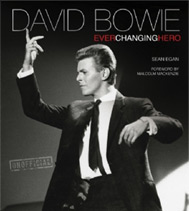Personalities | David Bowie | Reinvented for the Eighties
Bowie’s mega-success with his artistic low point was followed by what can only be described as a lost decade.
A Homeland No. 1 At Last
In 1979 Bowie had a non-album UK Top 10 hit with ‘John I’m Only Dancing (Again)’, a song that – the old rascal – bore no relation to his 1972 non-album No. 12 hit ‘John I’m Only Dancing’. The following year saw him gain his first UK No. 1 single that wasn’t a reissue. ‘Ashes To Ashes’ was a haunting sequel to ‘Space Oddity’ (coincidentally, his only previous chart topper) that suggested there were narcotics-related reasons for Major Tom’s space meltdown. The fact that the surreal video for the record – Bowie eerily playing pantomime character Pierrot – was the most expensive yet made seems now an indication of his apprehension that the MTV age was coming.
The Mainstream – Sort Of
The record’s parent album Scary Monsters (And Super Creeps) (1980) continued Bowie’s incremental return to the mainstream – or what, with him, passed for it. Yes, ‘Up The Hill Backwards’ had an instantly catchy melody but what did it actually mean? And surely most of the album’s guitars are out of tune? However, who could resist the likes of ‘Fashion’? This syncopated mocking of contemporary clothes horses was a UK No. 5 and the second of the album’s four Top 40 UK singles. This was all capped by ‘Under Pressure’ – his collaboration with Queen – climbing to No. 1 in the UK (No. 29 in the States).
Nobody could have predicted that this triumph heralded an abandonment of musical adventurism and an aesthetic nadir.
When Bowie had a UK Top 3 with Bing Crosby in the shape of ‘Peace On Earth/Little Drummer Boy’ in late 1982 – a legacy of a bizarre 1977 guest appearance on the old crooner’s TV show – his fans naturally dismissed it as much of an aberration as ‘The Laughing Gnome’, which belatedly made No. 6 in the UK in 1973. If only.
The man who had publicly said in 1976, ‘I really, honestly and truly, don’t know how much longer my albums will sell … And I really don’t give a s***’ now set about a cynical grab for the big time.
He brutally dispensed with the services of long-term producer Tony Visconti and turned to the in-vogue and very mainstream Nile Rodgers, Chic’s main man. Maybe Bowie felt obliged to do well for EMI America following his megabucks switch from RCA – $17.5 million dollars was a lot of money in those days.
Superstardom At A Price
The resultant album, released in 1983, was called Let’s Dance. More than a third of its eight songs weren’t even new: Bowie had co-written ‘China Girl’ a few years back for an Iggy Pop album, ‘Cat People’ was a re-recording of a soundtrack song that had been a minor hit for him the previous year and ‘Criminal World’ was a cover. Moreover, with...
AUTHORITATIVE
An extensive music information resource, bringing together the talents and expertise of a wide range of editors and musicologists, including Stanley Sadie, Charles Wilson, Paul Du Noyer, Tony Byworth, Bob Allen, Howard Mandel, Cliff Douse, William Schafer, John Wilson...
CURATED
Classical, Rock, Blues, Jazz, Country and more. Flame Tree has been making encyclopaedias and guides about music for over 20 years. Now Flame Tree Pro brings together a huge canon of carefully curated information on genres, styles, artists and instruments. It's a perfect tool for study, and entertaining too, a great companion to our music books.

David Bowie
Fantastic new, unofficial biography covers
his life, music, art and movies, with a
sweep of incredible photographs.


